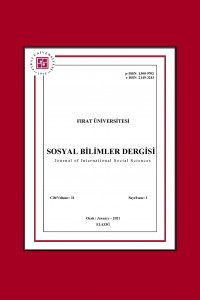Öz
Anahtar Kelimeler
Great Seljuk stucco ornament inscription Kerman Melik Mosque architecture
Proje Numarası
PYO.ILH.1904.18.001
Kaynakça
- Anisi, Aliriza (2004). “The Masjid-i Malik in Kirman”, İran: Journal of the British lnstitııte of Persian Studies, S. XLII, London: The British Institute of Persian Studies (BIPS), s. 137-157.
- Bâstânîy-î Pârîzî, Muhammed İbrahim (1343 h.ş). Tarih-i Kirmân, Selcukiyân ve Goz der Kirmân. Tahran: Neşr-i Bâstânîy-î Pârîzî.
- Cezar, Mustafa (1977). Anadolu Öncesi Türklerde Şehir ve Mimarlık. Ankara: Türkiye İş Bankası Kültür Yayınları.
- Derek Hill ve Oleg Grabar (1967). Islamic Archilecture and its Decoration A,D. 800-1500. London: DOI.
- Erdoğan Merçil (1989). Kirmân Selçukluları, Ankara: Türk Tarih Kurumu Yayınları.
- Hutt, Antony (1970). “The Three Minarets in the Kirman Region”, The Journal of the Royal Asiatic Society of Great Britain and Ireland, Vol. II, Cambridge: Cambridge University Press, s. 175.
- Korbendau, Yves ve Kirk Mcelhearn (2008). The Many Faces of Iran Poche Couieur and Travel Series. Washington: ACR.
- Kramers, Johannes Hendrik (1960). “Kirman”, DİA, Persian Cities, London: DİA, s. 147.
- “Kur'an-ı Kerim Portalı”, Diyanet İşleri Başkanlığı Kur'an-ı Kerim Portalı, Son Erişim: 24 Aralık 2019, https://kuran.diyanet.gov.tr/.
- Müstevfı Kazvînî, Hamdullah b. Ebî Bekr b. Muhammed b. Nasr (1336 h.ş). Nuzhet el-Kulûb. Muhammed Debîr-i Siyâkî (ed.), Tahran: Tehuri.
- Ring, Trudy, Watson, Noelle, Schellinger, Paul (2014). Middle East and Africa: International Dictionary of Historic Places. Vol. IV, London: Routledge.
- Schroeder, Eric (1964). "The Seljuq Period" in A Survey of Persian Art, ed. Arthur Pope and Phyllis Ackerman, vol. 3, London: Oxford University Press, s. 1033.
- Veziri, Ahmed Ali Hân (1340 h.ş). Tarih-i Kirman (Salâriyye), Tahran: İbn-i Sina.
Öz
Birinci Turanşâh'ın yaptırdığı Kirmân’ın en eski camisi Mescid-i Melik’tir. Caminin alçı mihrapları, Büyük Selçuklu döneminin zengin süsleme ve kitâbelerini içermesine rağmen, bu alçı süsleme ve kitâbeler üzerine yapılan ayrıntılı çalışmaların sayısı oldukça azdır. Buradan hareketle “Kirman Mescid-i Melik'in Büyük Selçuklu alçı mihrapları” başlığıyla hazırlanmış olan bu makalenin amacı, yapının alçı mihraplarını tanıtarak, böylece bu mihraplarının değerlerini ortaya koymaktır. Bu alçı mihraplarının çoğu kitâbe ve süslemeleri, zamanla harap olmuştur. Araştırmamız neticesinde, söz konusu yapının süsleme kompozisyonunun, yazı, bitkisel ve geometrik bezemeler içerdiği; bunun yanı sıra kabartma, kazıma ve ajur tekniğinde yapıldığı fark edilmiştir. Bu alçı süsleme ve kiâbelerin sanatçısı ile ilgili herhengi bir bilgi bu çalışmada tespit edilememiştir. Mihraplarda işlenen bazı alçı süslemeler, İran'ın Sasani dönemine (226-651) ait alçı süslemeleri, Nîşâbur’da yapılan kazı çalışmalarından çıkan İran’ın ilk İslâmî devirlerine (X. yüzyıl) ait süslemeler, Karahanlı (840-1212), Gazneli (963-1186), Anadolu Selçuklu (1075-1308) ve İran’ın İlhanlı dönemi (1256-1353) alçı süslemeleri ile benzerlik sergilemektedir.
Anahtar Kelimeler
Büyük Selçuklu alçı süsleme kitâbe Kirman Mescid-i Melik mimari
Destekleyen Kurum
Ondokuz Mayıs Üniversitesi BAP Birimi
Proje Numarası
PYO.ILH.1904.18.001
Kaynakça
- Anisi, Aliriza (2004). “The Masjid-i Malik in Kirman”, İran: Journal of the British lnstitııte of Persian Studies, S. XLII, London: The British Institute of Persian Studies (BIPS), s. 137-157.
- Bâstânîy-î Pârîzî, Muhammed İbrahim (1343 h.ş). Tarih-i Kirmân, Selcukiyân ve Goz der Kirmân. Tahran: Neşr-i Bâstânîy-î Pârîzî.
- Cezar, Mustafa (1977). Anadolu Öncesi Türklerde Şehir ve Mimarlık. Ankara: Türkiye İş Bankası Kültür Yayınları.
- Derek Hill ve Oleg Grabar (1967). Islamic Archilecture and its Decoration A,D. 800-1500. London: DOI.
- Erdoğan Merçil (1989). Kirmân Selçukluları, Ankara: Türk Tarih Kurumu Yayınları.
- Hutt, Antony (1970). “The Three Minarets in the Kirman Region”, The Journal of the Royal Asiatic Society of Great Britain and Ireland, Vol. II, Cambridge: Cambridge University Press, s. 175.
- Korbendau, Yves ve Kirk Mcelhearn (2008). The Many Faces of Iran Poche Couieur and Travel Series. Washington: ACR.
- Kramers, Johannes Hendrik (1960). “Kirman”, DİA, Persian Cities, London: DİA, s. 147.
- “Kur'an-ı Kerim Portalı”, Diyanet İşleri Başkanlığı Kur'an-ı Kerim Portalı, Son Erişim: 24 Aralık 2019, https://kuran.diyanet.gov.tr/.
- Müstevfı Kazvînî, Hamdullah b. Ebî Bekr b. Muhammed b. Nasr (1336 h.ş). Nuzhet el-Kulûb. Muhammed Debîr-i Siyâkî (ed.), Tahran: Tehuri.
- Ring, Trudy, Watson, Noelle, Schellinger, Paul (2014). Middle East and Africa: International Dictionary of Historic Places. Vol. IV, London: Routledge.
- Schroeder, Eric (1964). "The Seljuq Period" in A Survey of Persian Art, ed. Arthur Pope and Phyllis Ackerman, vol. 3, London: Oxford University Press, s. 1033.
- Veziri, Ahmed Ali Hân (1340 h.ş). Tarih-i Kirman (Salâriyye), Tahran: İbn-i Sina.
Ayrıntılar
| Birincil Dil | Türkçe |
|---|---|
| Bölüm | Araştırma Makalesi |
| Yazarlar | |
| Proje Numarası | PYO.ILH.1904.18.001 |
| Yayımlanma Tarihi | 20 Ocak 2021 |
| Gönderilme Tarihi | 16 Kasım 2020 |
| Yayımlandığı Sayı | Yıl 2021 Cilt: 31 Sayı: 1 |

